Reports
Reports summarize your data in grid tables, helping you analyze customer behavior and gain insights quickly. This guide shows you how to create reports, configure metrics and filters, and customize visualizations.
Reports in Bloomreach Engagement
Reports in Bloomreach Engagement are analytical tools that display your data in grid tables. You specify which attributes or events appear in rows and columns, then choose a metric to measure. The report generates a table where each cell shows the number of customers or events that satisfy the row and column settings. You can automatically highlight important cells or visualize the table as a chart.
Tip
If you use pivot tables in Microsoft Excel: Reports work similarly to Excel pivot tables, so you can transfer your knowledge directly.
Watch this introductory video about reports.
Example: Purchase patterns by day and hour
Suppose you want to understand when customers make purchases throughout the week. Create a report with:
- Columns: Weekdays of purchase
- Rows: Hours of purchase
- Metric: Total number of purchases (or average price, or total revenue)
The result shows purchase patterns across the week, helping you identify peak shopping times.
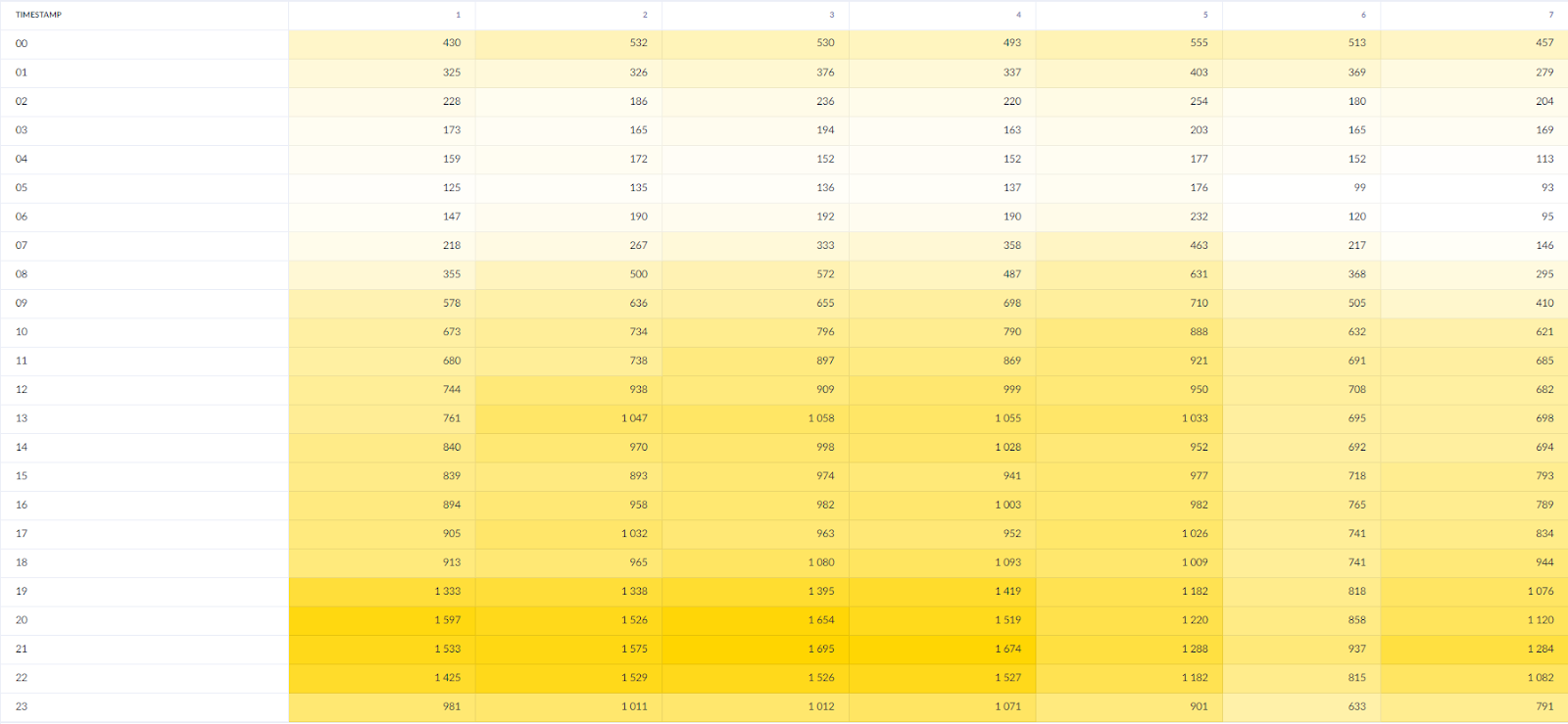
The table created as in the example showing the number of purchases, highlighted yellow to white.
Learn how to do this in the "Weekly Heat-map" Analysis article.
Report improvements
We made major changes to the UI of reports, making them more user-friendly. Watch this video to understand how to make the most out of Reports now.
Understand the data
For each customer, your database will contain a lot of events and customer attributes. However, to give the data meaning, you will almost always need to condense and visualize your data. Reports allow you to summarise your data into a comprehensible structure of a grid table, which you can further clarify using either highlighting or the chart view. This gives you quick insights into the raw data stored in Bloomreach Engagement.
For a guide through a typical use case, view this article about creating a report from A/B testing.
Create reports
Access the report tool.
- Go to Analyses > Reports.
- Click the + sign next to Reports.
- The report editor opens with a blank report.
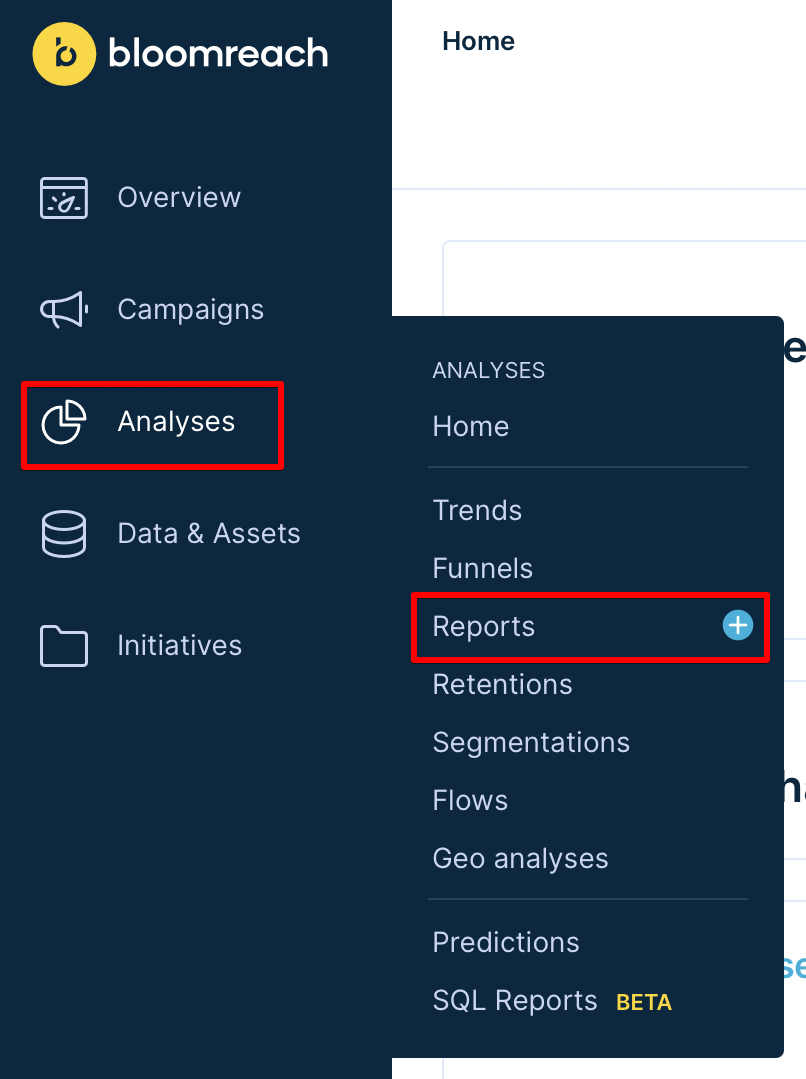
Reporting template library
The analytics template library offers predefined report templates to help you get started.
To use a template:
- Go to Analyses > Reports > + New report.
- Search for templates:
- By tags
- By keywords in name and description
- By use case and feature
- Select a template and edit as needed.
All users who can edit the analysis can import templates.
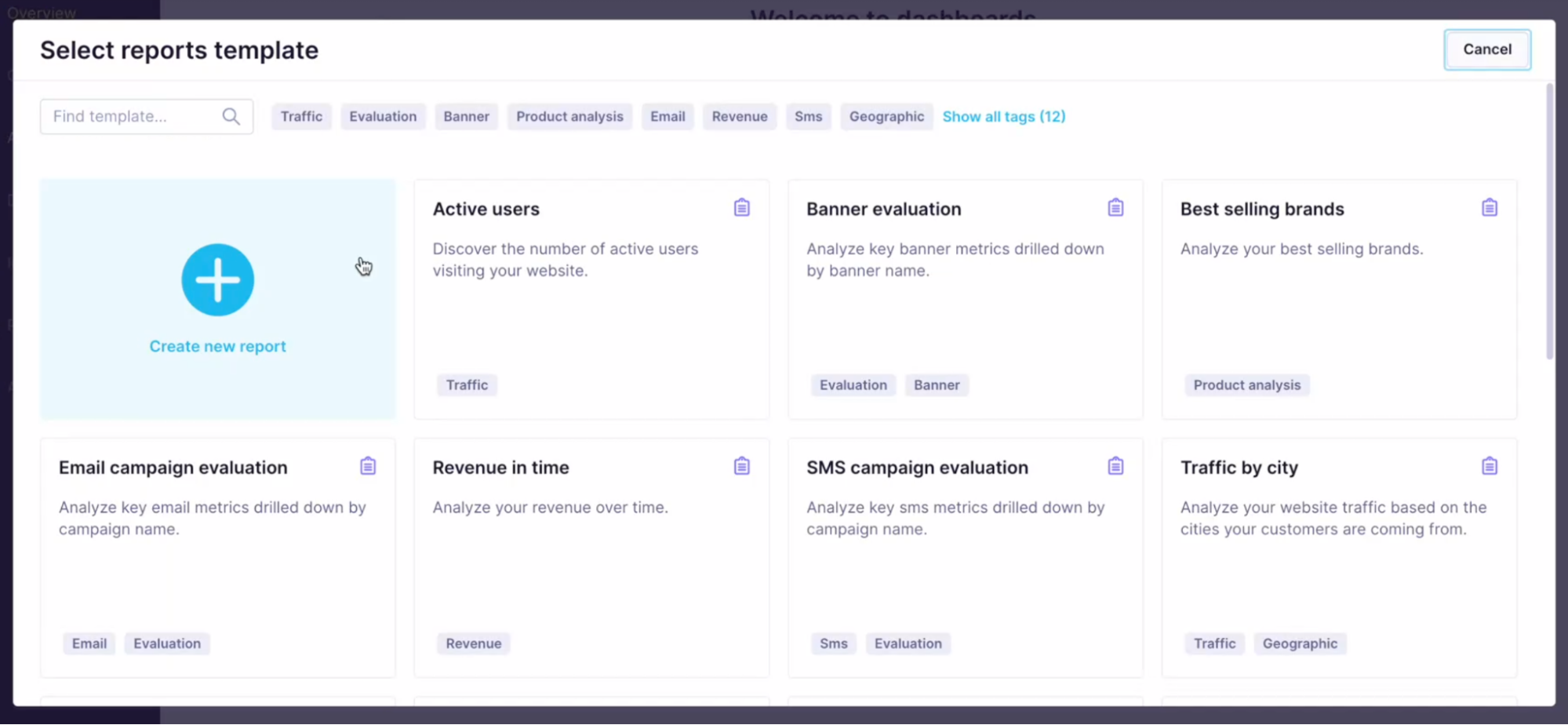
Understand the report editor
The report editor has two main parts.
Building part
Define what you want to measure:
- Metrics: What to measure (customer count, event count, revenue, and more)
- Drill-downs: How to organize results (rows and columns)
- Filters: How to filter data (date range, customer segments, value thresholds)
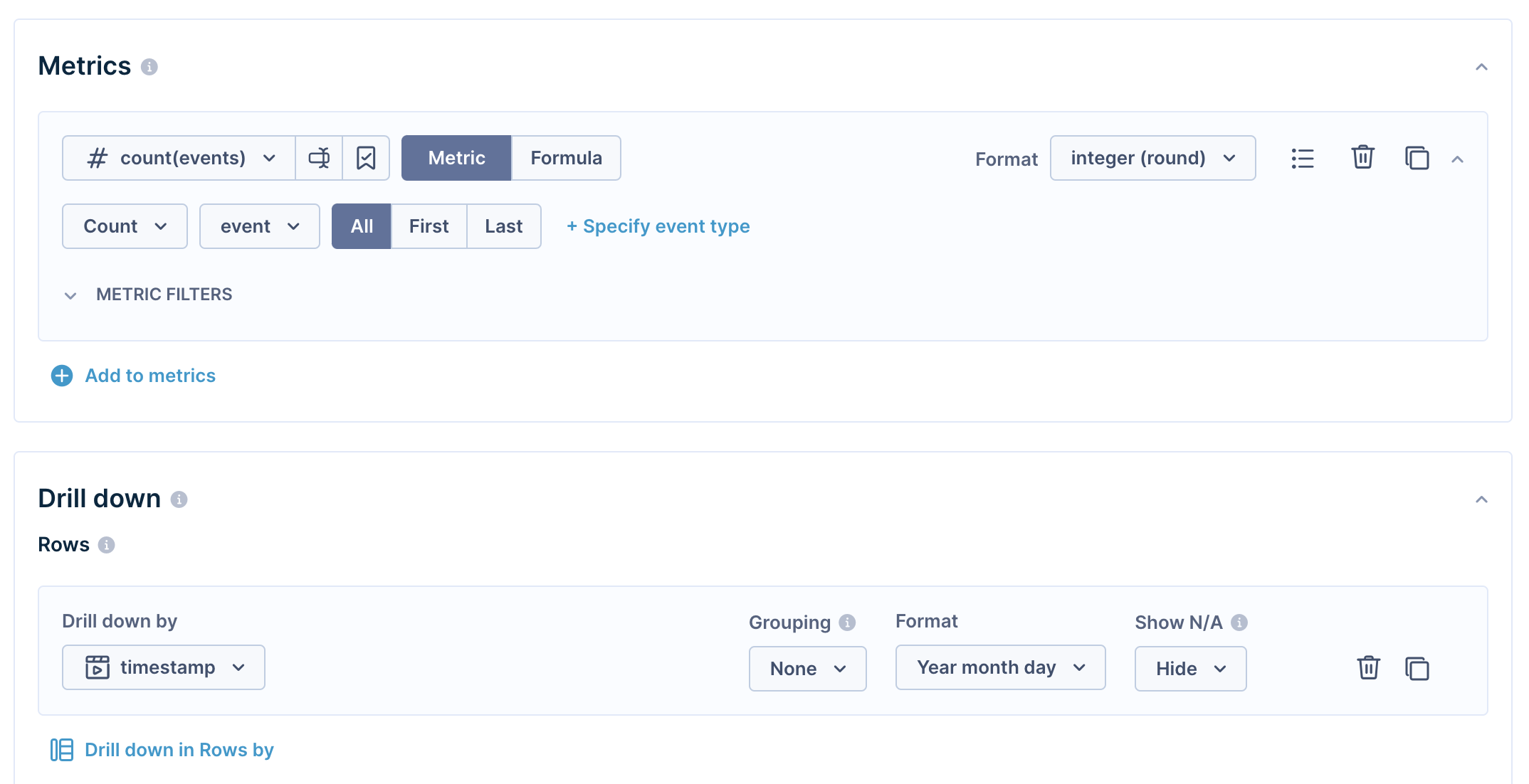
The initial configuration of a new report
Results section
See calculated results and customize display:
- Adjust time range
- Change formats
- Add heat maps
- Switch between table and chart views
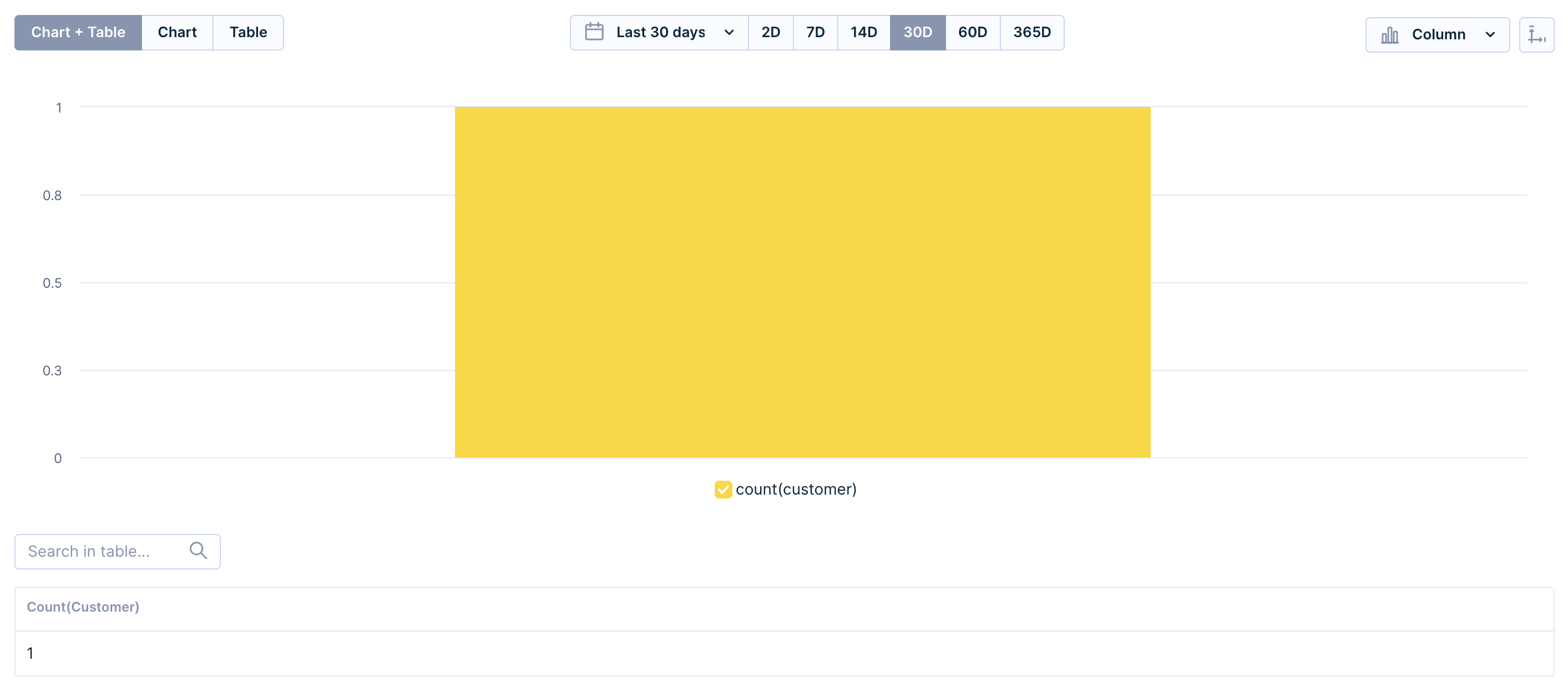
The Results part of the Report Editor
How the report editor works
The report comes with one metric already filled in (customer count). Customize it to your needs.
The Rows and Columns sections in this Table editor correspond to the rows and columns of a table. In turn, this table will be used as the basis for the output chart.
The Report Editor will generate a bar graph by default. Here, the row attributes represent the values of the x-axis of the bar chart, and the column attributes are represented by one or more bars per value on the x-axis. The Metrics section in the table editor represents the values on the y-axis of the bar graph.
In the Metrics filters, you can filter the Time range of the events you want to calculate in the metric.
And finally, in the Value filter, you can filter specific results of the metric. The example below will filter out results based on whether the number of customers is greater than 10,000.

Don't forget to give your report a name and save it, so your valuable work will not get lost.

Specify report settings
Metrics
Metrics compute values in the table according to the drill-down specified in rows and columns. For example, metric customer count, when combined with session start > country attribute in rows, will compute how many customers started a session in given countries.
You can create a metric to measure the number of customers or events. You have the option to either create a new metric in Reports or use existing metrics from your project to avoid duplication and maintain its structure.
When building the metric from scratch in reports, you can always save it for further analysis in the project so you can just pick the metric from the project and don't waste your time on repetitive building of the same definition.
Note
Refer to this guide for more information about metrics.
You have two main options for building a metric definition:
- Using a simple metric
- A simple metric measures a singular aspect.
- Using a formula
- Formula allows you to combine multiple simple metrics or constant numbers and perform various mathematical operations to create more complex calculations.
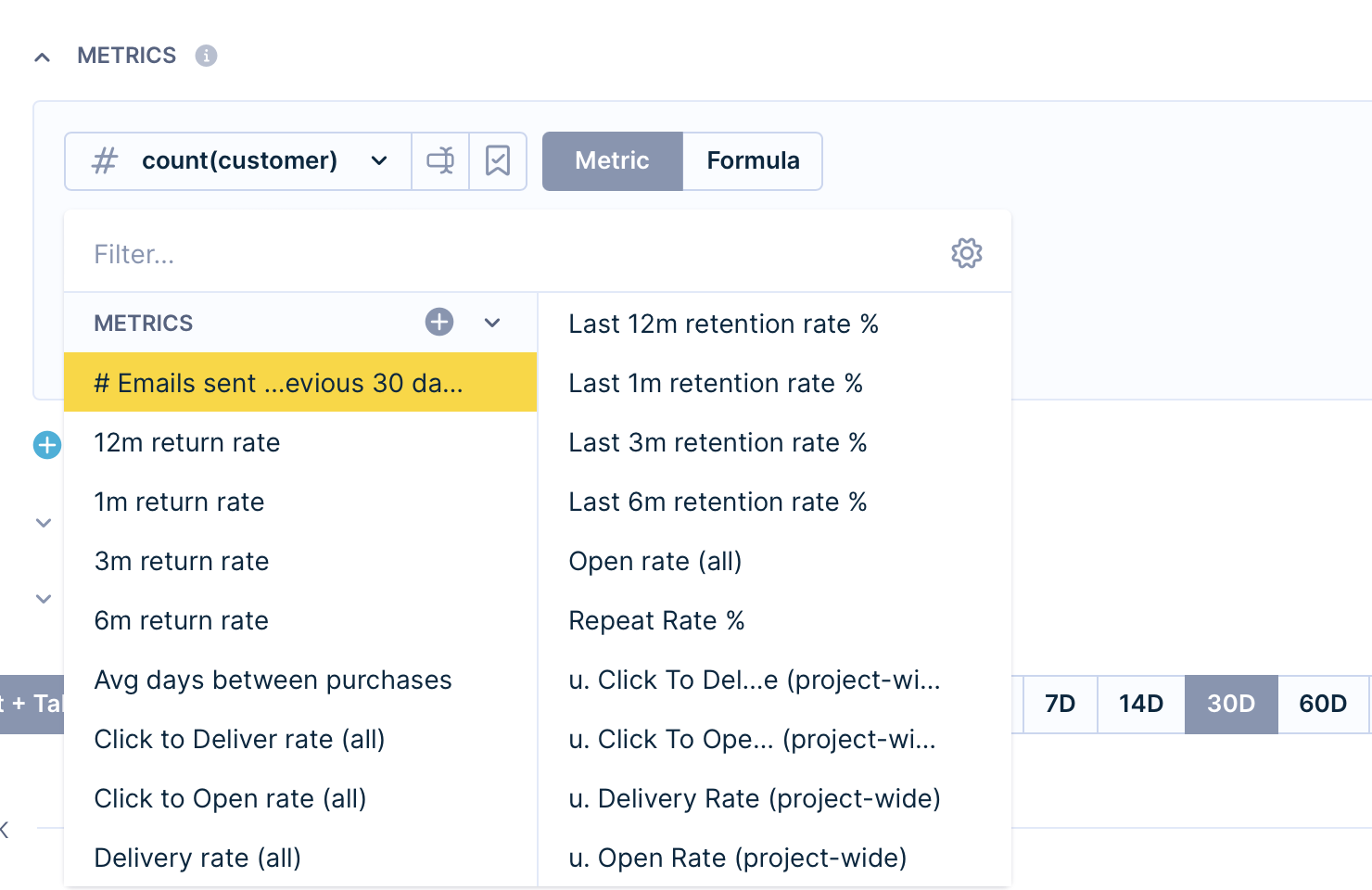
Metrics part of the Report Editor
Create new or edit existing analysis
You can create or edit existing Segmentations, Event segmentations, Expressions, Aggregates, or Running aggregates without having to leave the page.
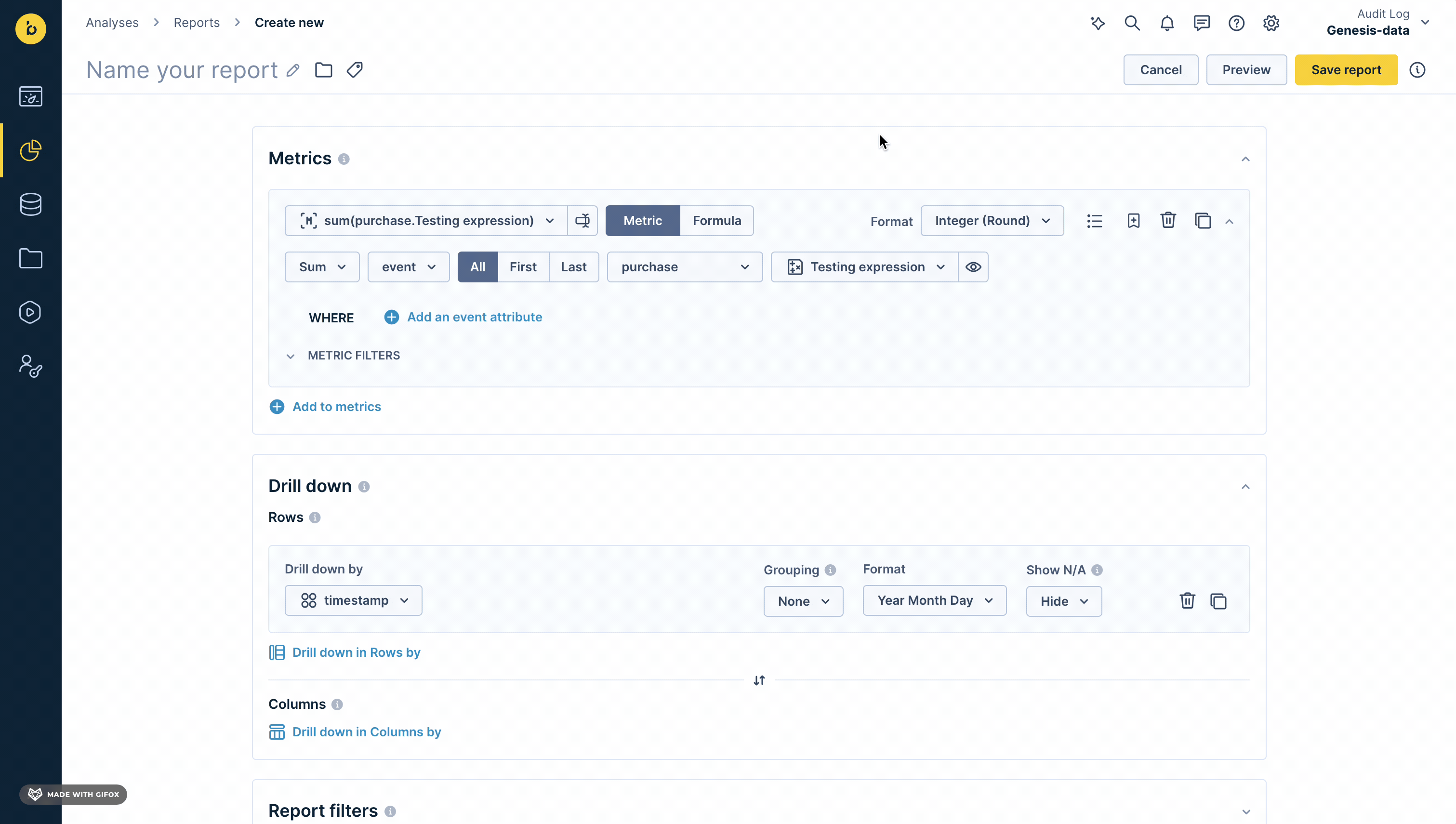
When you edit a definition in a Report, you can choose to apply the changes to the definition in all instances, or just for the specific Report.
Aggregations
On the left of the Metrics part, you can choose from six predefined aggregates:
- Minimum: Minimum of a numeric property value.
- Maximum: Maximum of a numeric property value.
- Sum: Sum of a numeric property value.
- Count: Number of customers.
- Average: Average of a numeric property value.
- Exists: Existence of at least one.
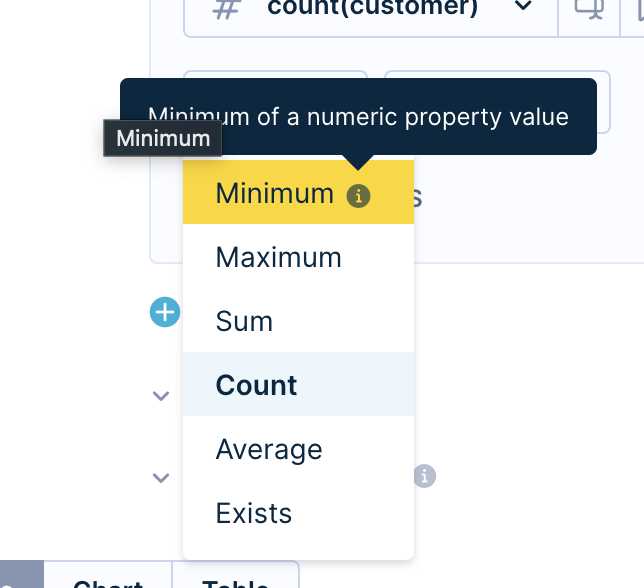
Formats
Formats allow you to format values in the report. Choose from the drill-down on the right side of the Metrics part. Only one filter can be applied at a time.
- Default
- Date format - format to be as specific as minutes or as broad as quarters.
- Date part - format to be as specific as minutes or as broad as years.
- Date difference - applicable to the timestamp value; refer to some time ago, ranging from "seconds ago" to some "years ago" reflected in the chart as the time passed from the chosen value in an ascending order.
- Numeric
- Floating - with a decimal point.
- Integer (round) - round number.
- Percent - %.
- Financial - $, €, £...
- Rounding - up to 4 digits.
In case sorting in the report produces unexpected results, try to manually set the format corresponding to your data.

Filters
Date filter
The Date filter determines the time period for report calculations. It only affects event aggregates and segmentations, not customer attributes.

Please read the Filtering data article to learn more about Date filters.
Customer filter
You can specify an additional customer filter meaning that only the customers who pass this filter will be used for the report. For example, only those that have a valid email.

Please read the Filtering data article to learn more about Customer filters.
Value filter
Here, you can filter specific results of the metric. The example below will filter out results based on whether the number of customers is greater than 10,000.

Drill-down
In the Metrics you are defining the values you want to see. In Drill-downs, you organize those results in Rows or Columns.
You can drill down both by using various events or customer properties, such as expressions, segmentations, aggregates, and more.

The Rows and Columns sections in this Table editor correspond to the rows and columns of a table. In turn, this table will be used as the basis for the output chart.
You can also use drill-down directly in the table.
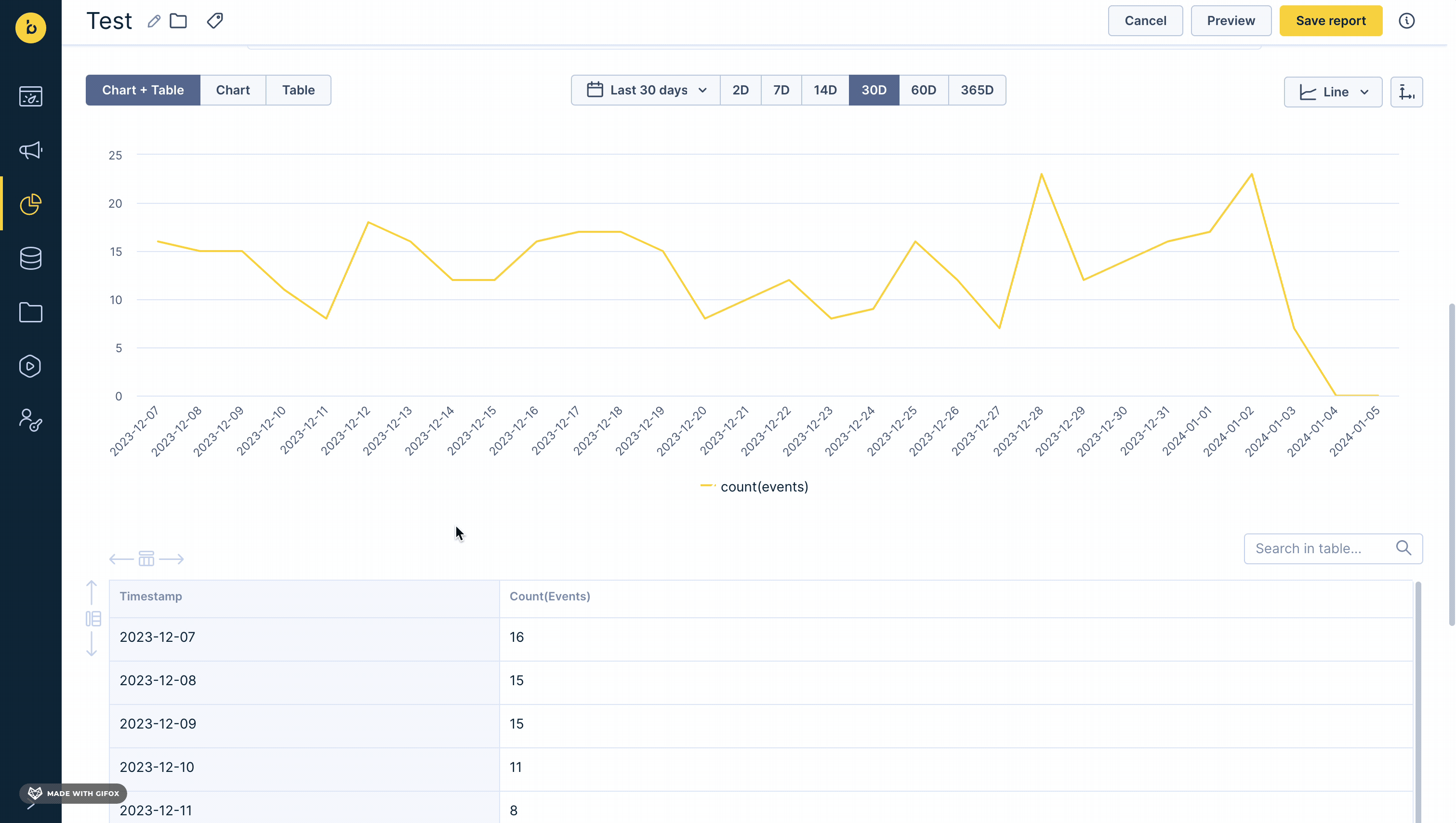
The Report Editor will generate a bar graph by default. Here, the row attributes represent the values of the x-axis of the bar chart, and the column attributes are represented by one or more bars per value on the x-axis. The Metrics section in the table editor represents the values on the y-axis of the bar graph.
If you use drill-down in Rows, the groups will appear in the first column of the table.
In the example below, we drill down in Rows using an expression counting the average number of days between purchases. The groups of buyers with a similar number of days between purchases can be seen in the first column of the table. In the chart, you see them on the x-axis.
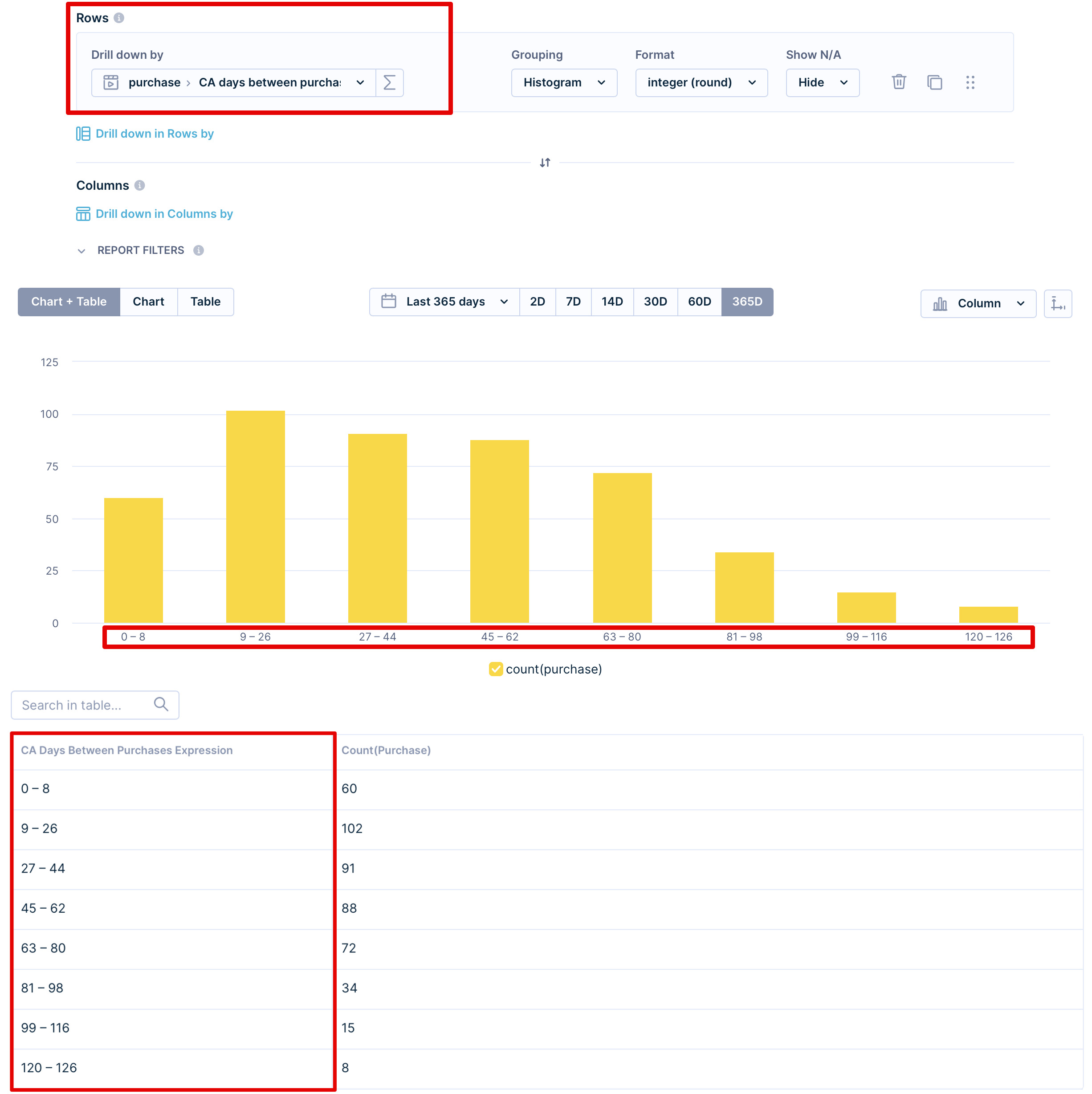
If you use columns for the drill-down, those groups will appear horizontally.
In the example below, we drill down in Columns using the Segmentation "Returning customers" to find out the amount of revenue from returning customers based on how much they have purchased. The chart displays one bar as it depicts the proportion of the revenue generated by particular segments.
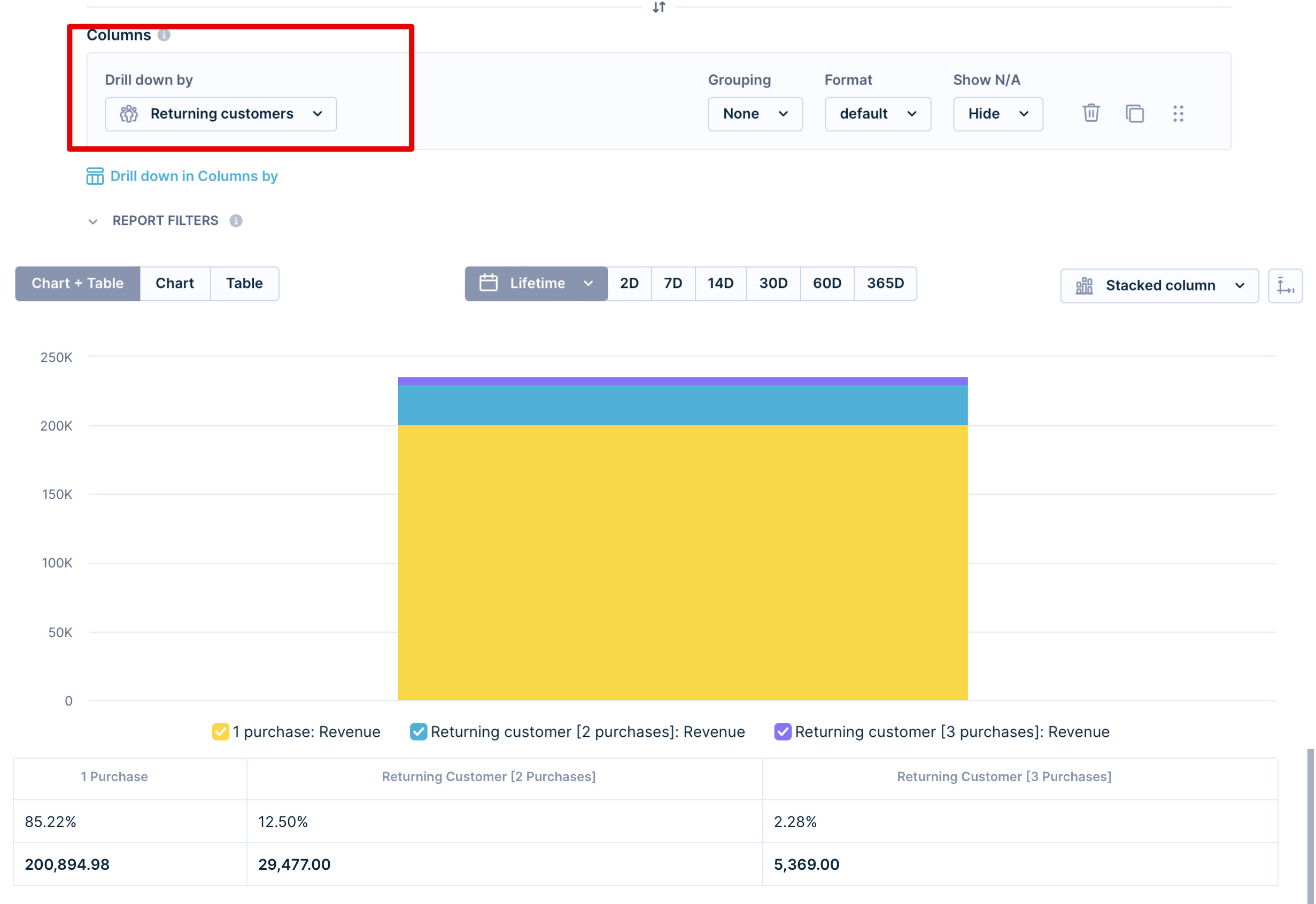
If you want to see how your metrics evolve over time, drill them down by timestamp as shown below. Similarly, if you want to see campaign-related metrics for each campaign, drill metrics down by campaign_name.

Grouping
Grouping is useful when there are too many values to display or you want to group the values based on certain properties.
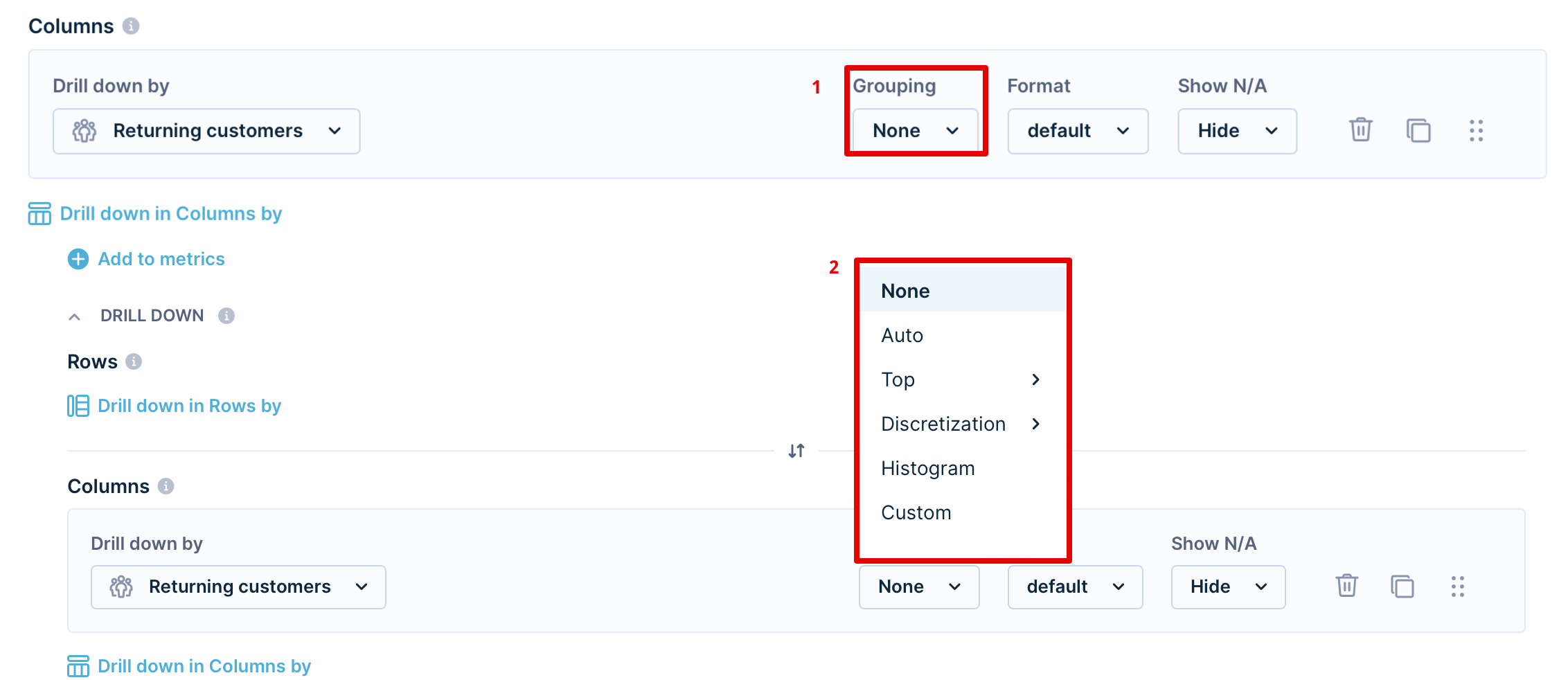
Grouping options:
- None: Disables any grouping
- Auto: Selects the best possible grouping based on the attribute
- Top: Selects only first X values (max 9 999) in rows according to the first metric used in the report.
- Discretization: Creates equally large groups, the number defines the number of groups.
- Histogram: Automatically creates groups from available values based on average and standard deviation to create a histogram-like distribution.
- Custom: Make your own grouping by inputting at least one number creating a left-closed interval.

In the discretization grouping, if one value is significantly more prevalent than other values, the number of groups might end up being smaller.
Formats
Choose from several formatting options for your drill-downs:
- Default
- Date format - format to be as specific as minutes or as broad as quarters.
- Date part - format to be as specific as minutes or as broad as years.
- Date difference - refer to some time ago, ranging from "seconds ago" to some "years ago."
- Numeric
- Floating - with a decimal point.
- Integer (round) - round number.
- Percent - %.
- Financial - $, €, £...
- Rounding - up to 4 digits.
- String
- Original case
- Capitalize
- Uppercase
- Lowercase
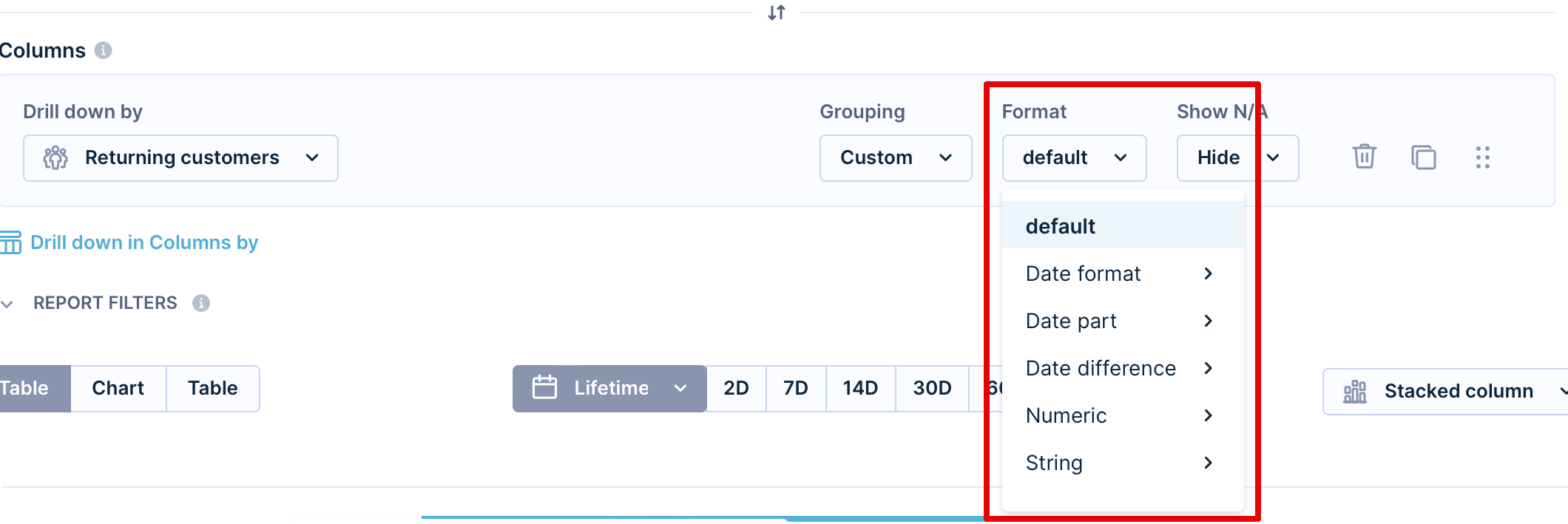
Show N/A
Enabling the "Show N/A" option displays also undefined values and allows users without a value for the field to still perform calculations.

Report filters
Report filters are superior to metric filters. However, they do not overwrite the metric filters but create a common intersection.
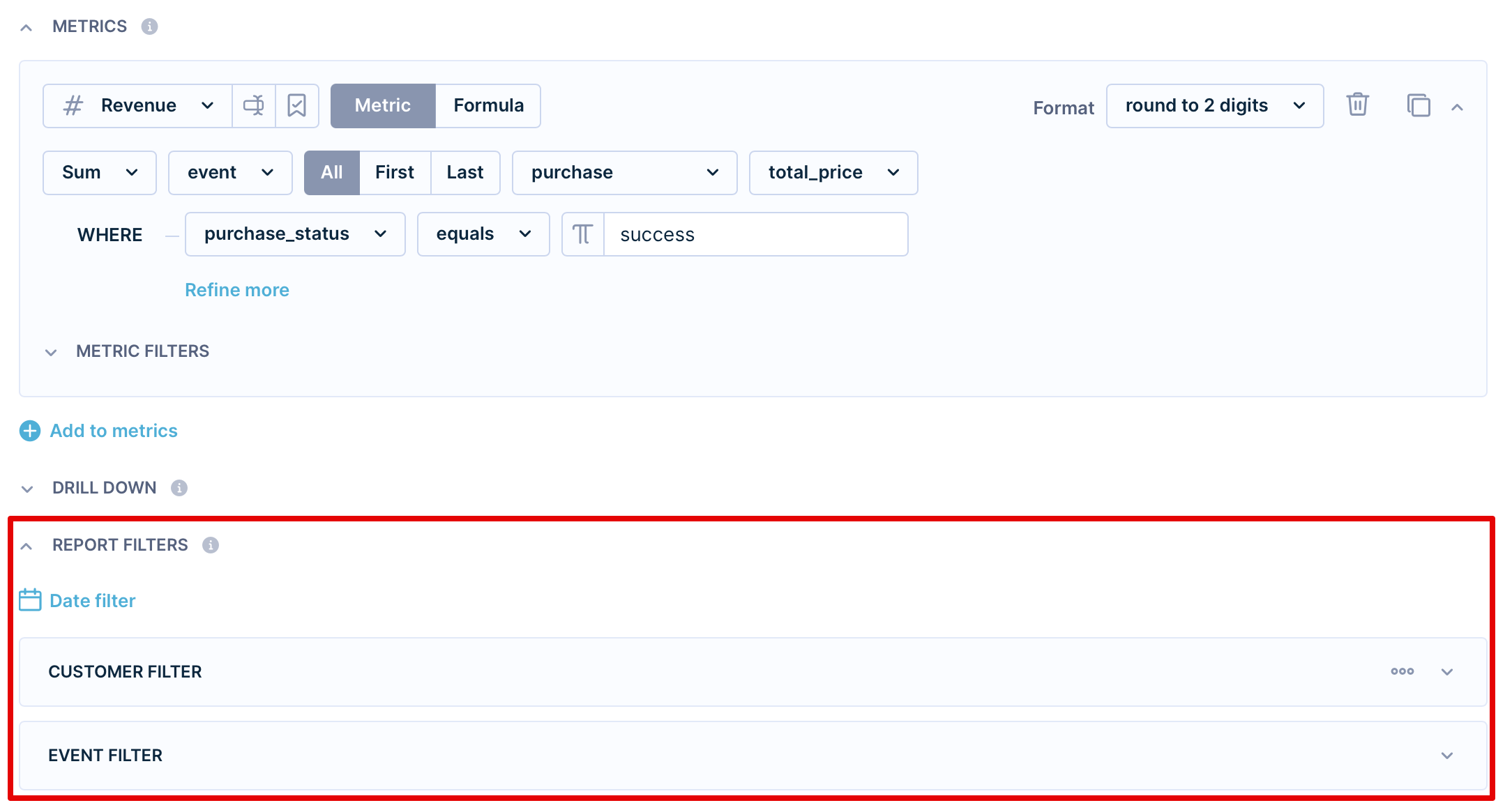
Actions
On the right-hand side of each field in the report definition, you'll find a delete icon, duplicate icon, and move icon. Click on the delete or duplicate button to either delete or duplicate the row or click and drag the move icon to move the field up or down.
Limitations
In reports, the number of:
- Rows is limited to 9 999
- Columns is limited to 99
- Metrics is limited to 249
- Cells is limited to 200 000
Trying to go beyond any of these limits will result in an error.
If these limits aren't sufficient, consider dividing the report into smaller chunks or using features such as Exponea Big Query or Exports, that make all the data available to any complex analytics.
Moreover, for long JSONs, the output might be too large. In this case, follow these steps:
- Try to change the Grouping in Rows from None to any other grouping that will give you less than 9999 rows
- Try to change the Grouping in Columns from None to any other grouping that will give you less than 9999 rows
- Try to change the time range
Report view
You can display your report as:
- A table
- A chart
- Both
Chart
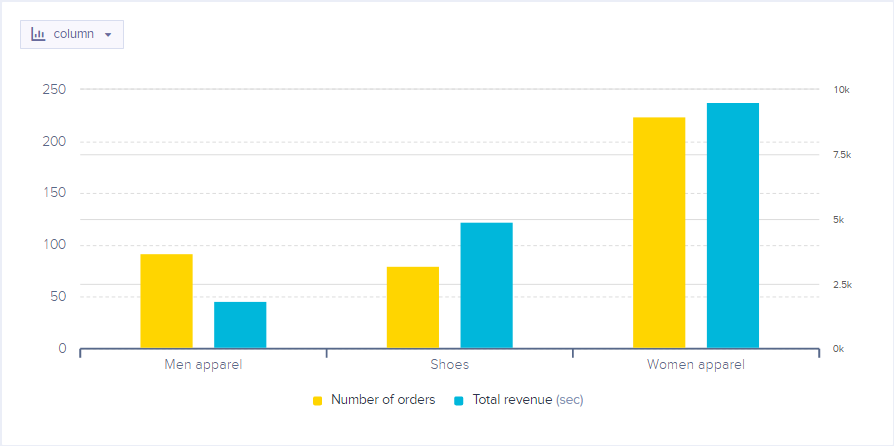
Customize your chart view by clicking on it. You will see a menu where you can change:
- Series type: Choose your preferred chart type. Types are explained below.
- Series color: Choose your preferred color for the chart.
- Y-axis: You can set the Y-axis as your primary or secondary one.
- Format: Format your data to your liking. For example, these results are rounded to 3 decimal points.
- Show customers: Preview the customers in the report. By clicking on the "Show customers" option, you will be navigated to Data & Assets > Customers with the relevant customer filter. The feature doesn't apply the filters which are used within the Metrics filter but only the ones within the Report Filter section.
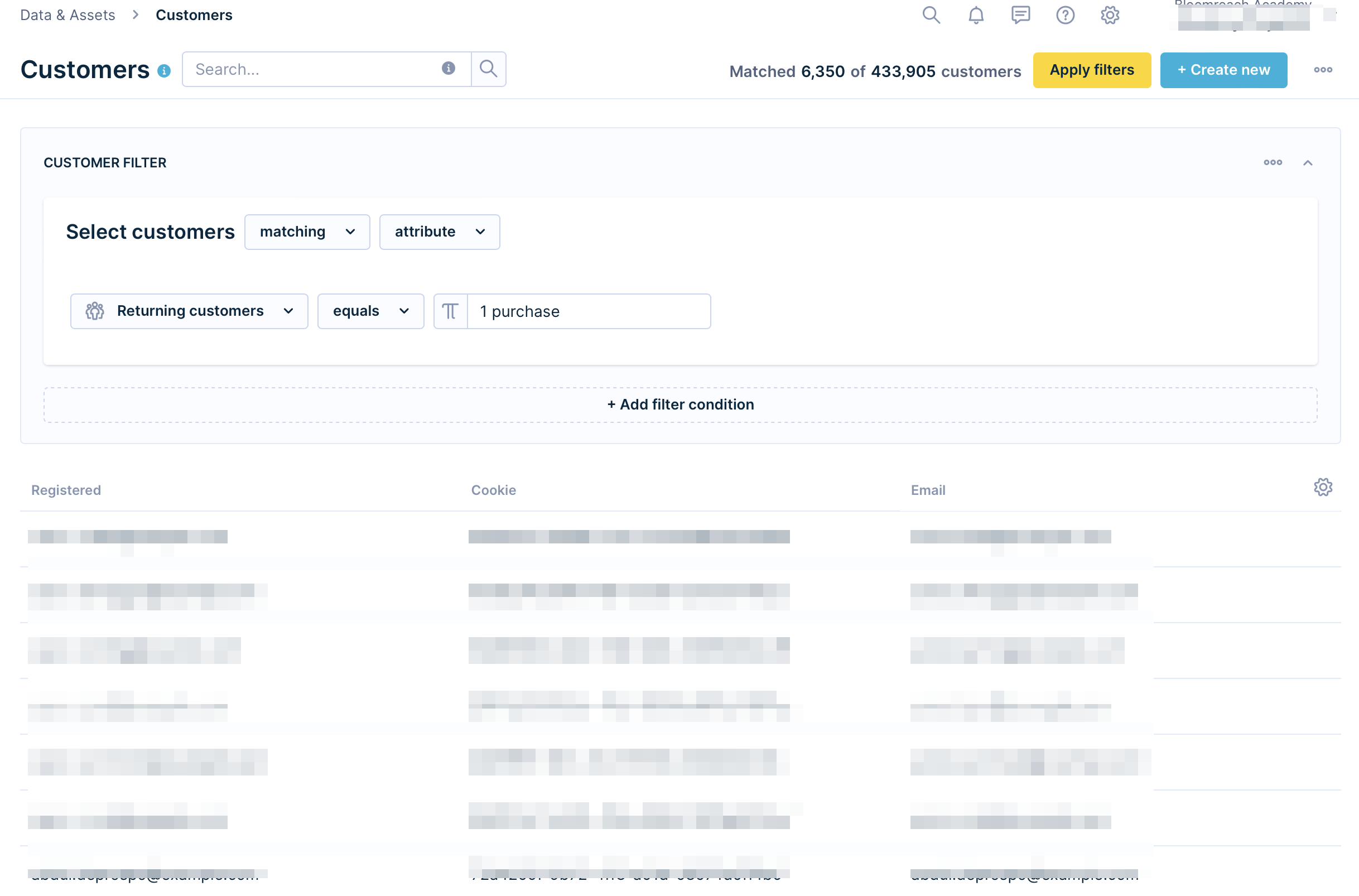
- Send campaign: Set up a campaign for the relevant customers. By clicking on "Send campaign," you will be redirected to a Scenario with relevantly pre-filtered conditions.
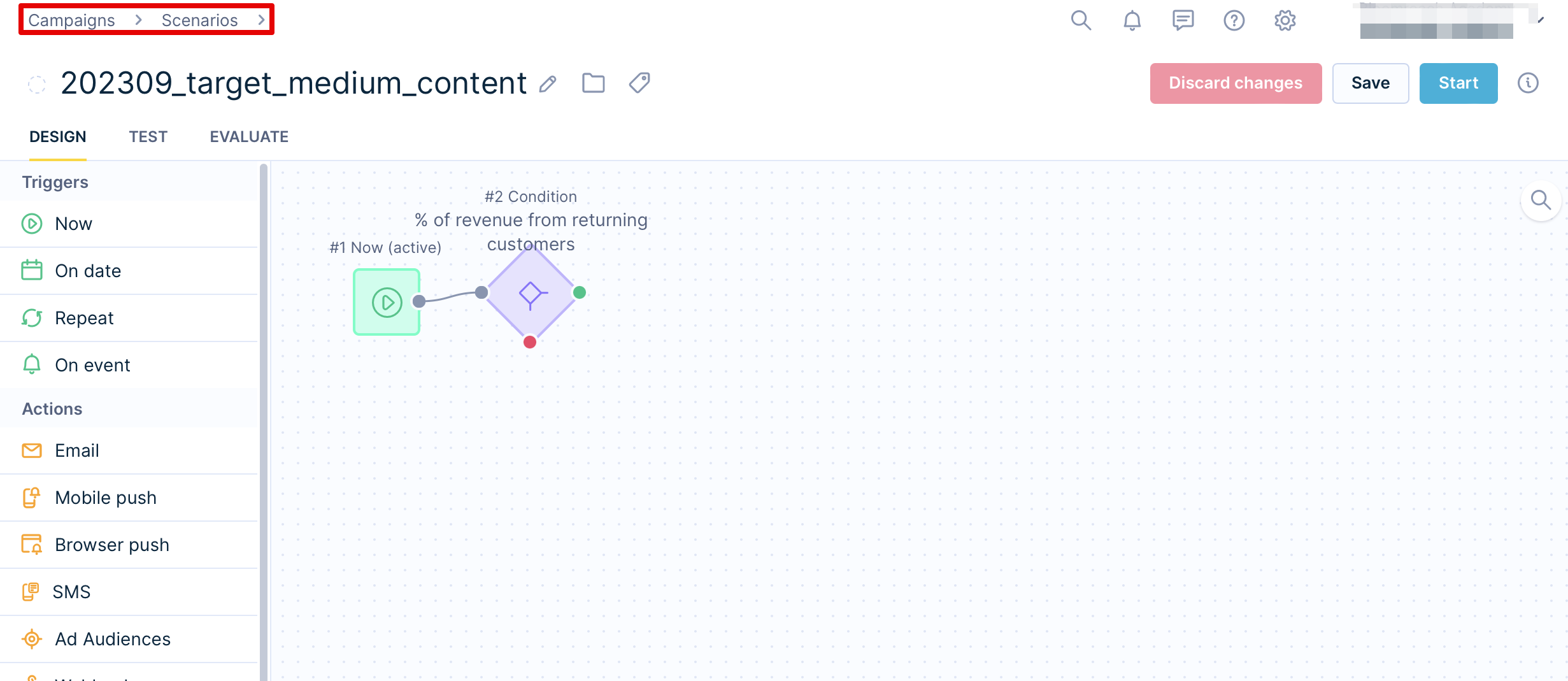
Series type
By default, the Report view will select the most appropriate chart type to display the contents of the table.
There are 8 types of charts available in the reports:
- Column: A classic column chart
- Stacked column: Available when using field in columns
- Bar: Limits to 15 values
- Line: Adjusts y-axis based on the values (can start from negative values)
- Area: Doesn't adjust the y-axis (starts from 0)
- Pie: Shows additional information on hover (percentage of the whole)
- Percentage area
- Bubble: To create a bubble chart (more complex scatter plot), you ideally want to have a report with:
- One row - the different values in this attribute will determine the discrete bubbles
- One column - the different values in this attribute will determine the color of the bubble (overrides the fourth metric)
- Up to 4 metrics:
- The first metric will determine the size of the bubble.
- The second metric will determine the position of the bubble on the X-axis.
- third metric will determine the position of the bubble on the Y-axis.
- fourth metric will determine the color of the bubble.
Timeframe
Above the chart, you can set up the timeframe of your choosing:
- Lifetime
- Last 2 days
- Last 7 days
- Last 14 days
- Last 30 days
- Last 60 days
- Last 365 days
This doesn't override the metric date but finds an intersecting time period.
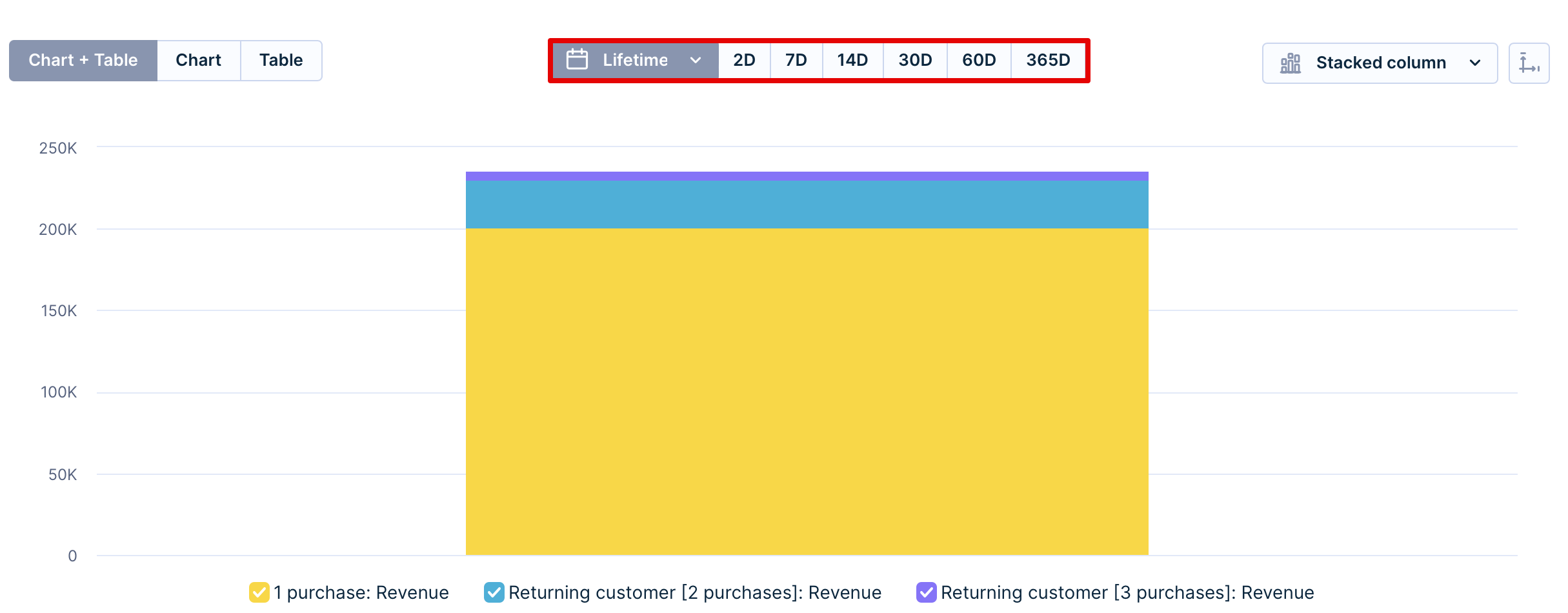
Axis limits
To compare your reports more effectively, you can set maximum and minimum limits for both axes. This way, you focus on the relevant data eliminating outliers and extreme values that distort your view. By applying consistent axis limits across multiple charts, you can compare and identify patterns or correlations between different metrics.
For example, you might want to compare the average order value (AOV) across different customer segments. You categorized your customers into three segments: new, regular, and VIP customers. By setting the same axis limits for AOV in each report, let's say $0 to $1000, you can focus the analysis on AOV within this range. This helps eliminate any extreme values or outliers that might skew the comparison across the customer segments. You can easily spot any patterns or trends in AOV for each customer segment. For example, if the AOV for VIP customers consistently falls within the upper range of $800 to $1000, while regular customers have a range of $300 to $500, you can identify the distinct purchasing behaviors of these segments.
To set it up, click on the very right icon. If there is data outside the shown chart, it will warn you with a warning sign.
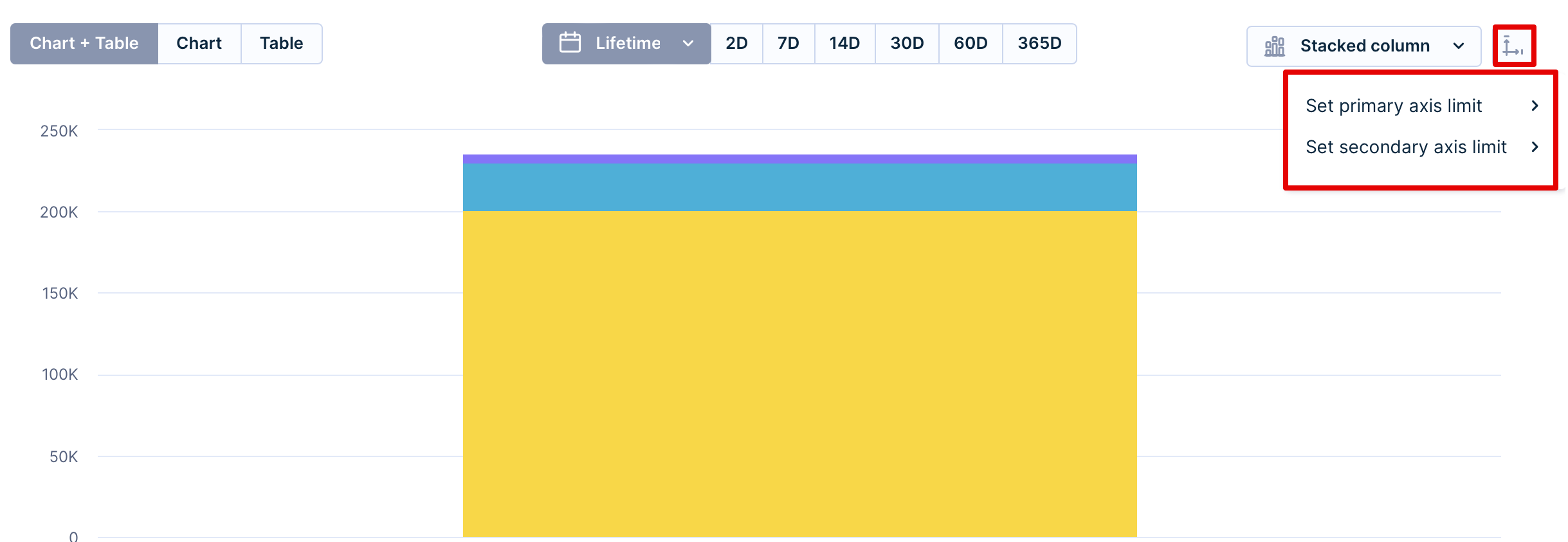
Table
In case your report is larger than your screen, scroll horizontally or vertically and both, the header and the first column are frozen. It helps you with better navigation when having large reports.
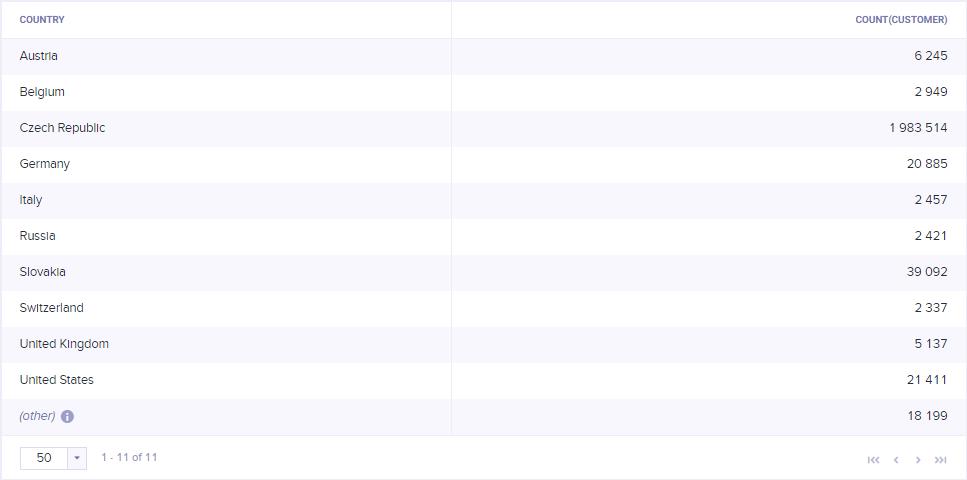
Example: a report with session start > country in rows and count customer metric
Modifiers
There are multiple modifiers in report metrics, which help visualize the data in tables. Hover over the table and click on the "View options" icon in the upper-right corner.
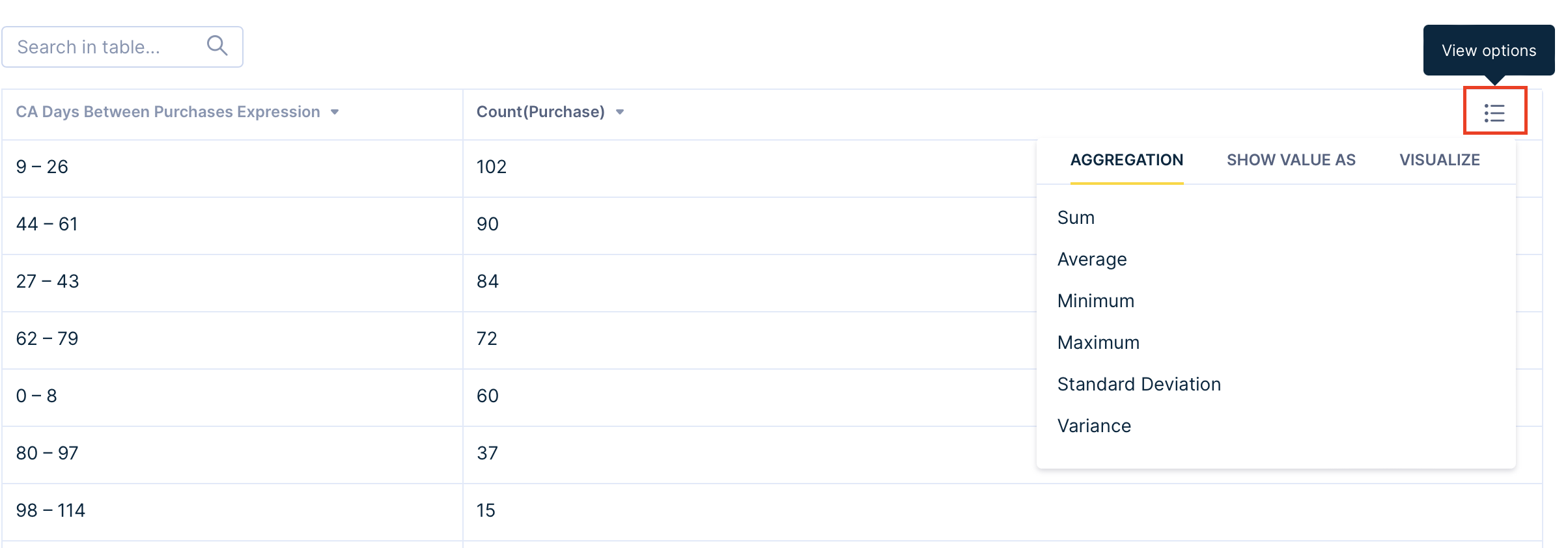
There are three categories: aggregation, show value, and visualize.
- Aggregation provides some statistical data about the metric at the bottom of the rows. You can choose from the sum, average, maximum, minimum, standard deviation, and variance.
- Show value as
- Column total % shows the percentage distribution within the column
- Grand total % shows percentage distribution considering all columns
- Running total counts values from all previous rows up to the current one, being effective in YTD revenue reporting
- Running total % counts percentages from all previous rows up to the current one, resulting in the last row always being 100%
- Visualize
- Heatmap changes the background of the cells based on their value in the selected color scale
- Highlight changes in the background of the cells based on the selected condition
Send via email
Bloomreach Engagement provides you with the option to receive updated reports directly in your email account on a regular basis. This allows you to stay up to date on the latest developments regarding your project.
In order to set this up, navigate to … > Send via email. There you can set how often you wish to receive updates on the Report.
You can choose to receive it:
- Daily – you will receive the Report every day at 8 a.m.
- Weekly – you will receive the Report every Monday at 8 a.m.
- Never – you will not receive the Report.

To review all the Reports you are receiving, navigate to your profile, and go into the email digest tab. There you will be able to view what Reports and other analyses you are currently subscribed to. You can also choose to stop receiving them by clicking on the trash can icon.

Hide or exclude data from reports
In some cases, there is a need to hide cells in the report table or exclude specific values to declutter data. Let's take a simple report to illustrate all the options. It has one count event metric, a timestamp attribute added to rows, and an event property added to columns.
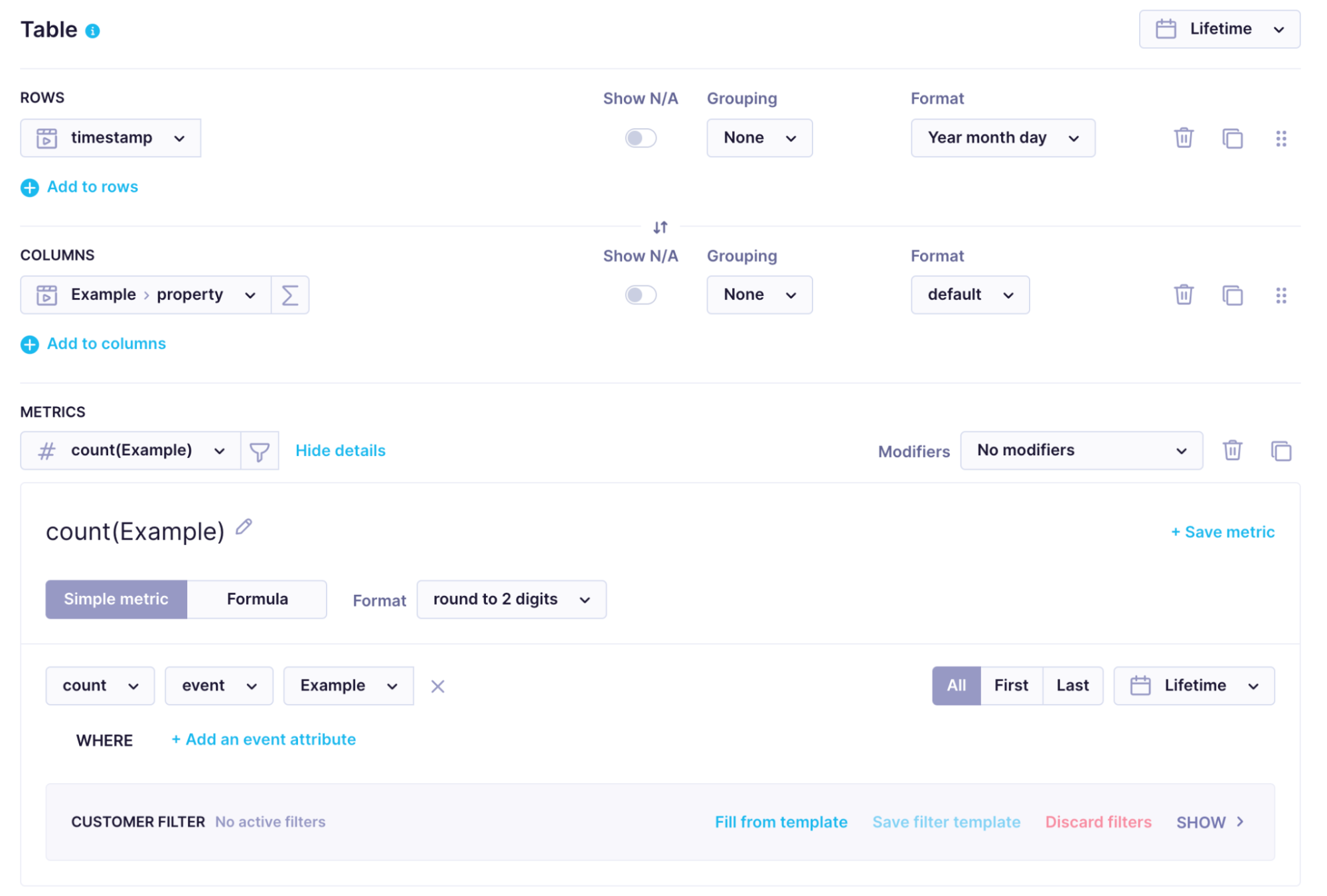
No filters are applied.

The results table of the report looks like this:

Following is a list of ways you can declutter a report.
Use hide N/A option
You can hide values that are not defined with the hide N/A option in rows and columns. The hide N/A option is enabled in reports by default.

Use grouping option
Another option is to use grouping options, which allow you to group results based on values. Let's look at our example report with this option enabled versus disabled.
An example of a report with enabled grouping.


An example of a report with disabled grouping.


Use metric filters
The next possibility is to use a metric filter to hide certain results returned by the metric. Note that a few changes were made to rows and columns of our example report to illustrate this filter.

An example of a report with no metric filter.
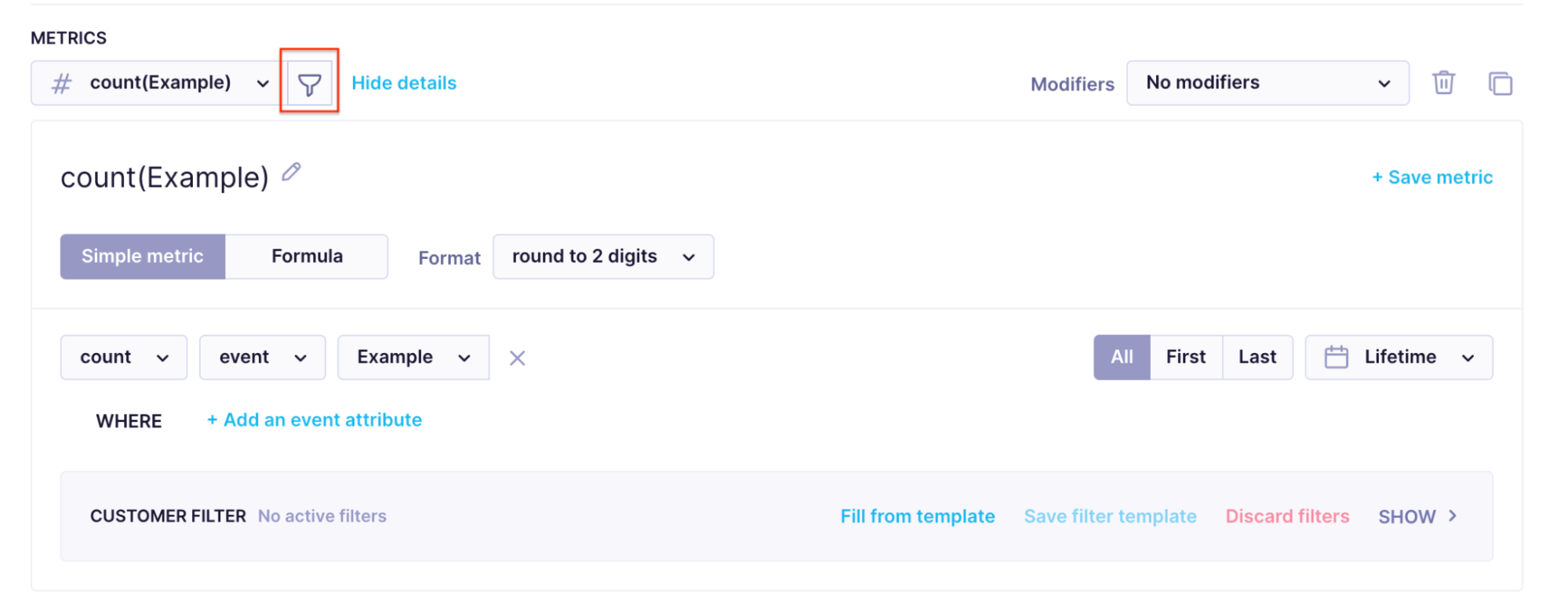

An example of a report with a metric filter.


This option is helpful if you want to check how many customers have the same email address if the metric filter is used in combination with customer metric and the email property in rows.
Use event filter
The next option is to use an event filter to exclude events with certain values. For example, it is helpful if you would like to check only certain campaign event statuses.
An example of a report with no global event filter applied


An example of a report with a global event filter applied


Use metric modifiers
The final option on the list is to use metric modifiers to hide the other group in the report. Adding any modifier will hide the other group. Review the following example for more context.
Example of a metric with a modifier.


Example of a metric with no modifier.
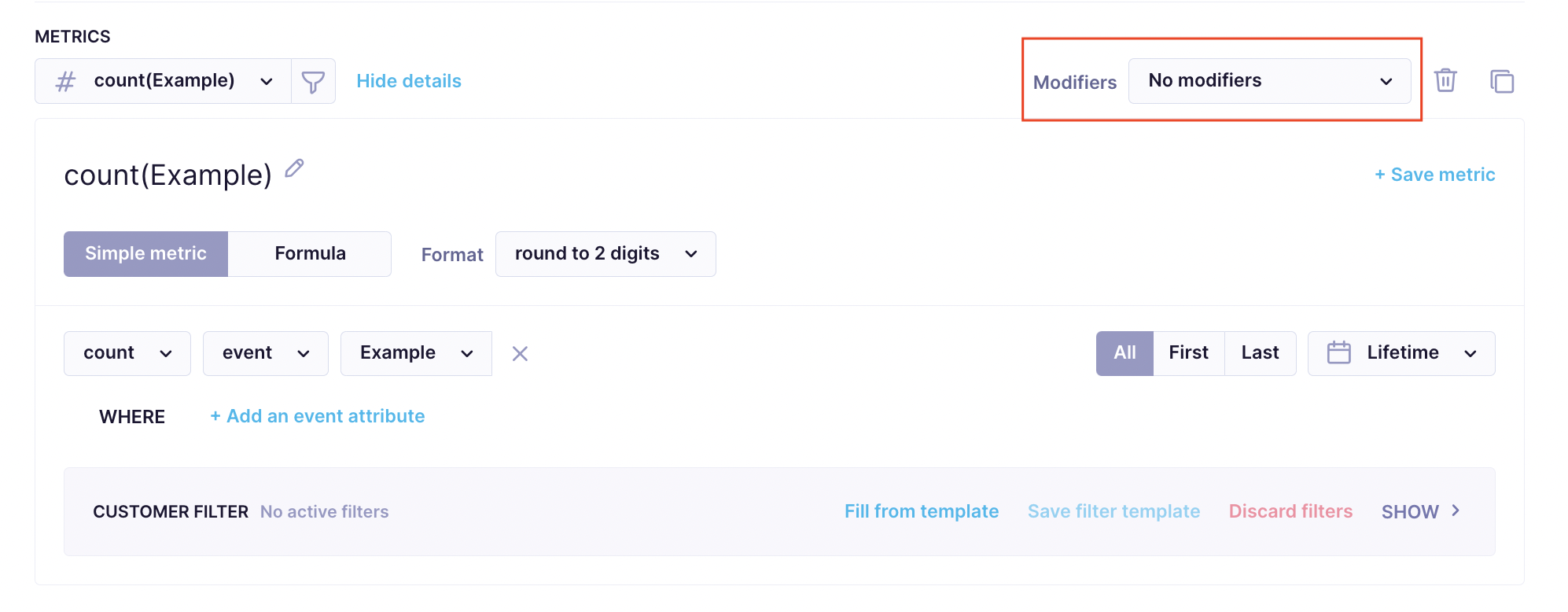

For more information on data filtering available in reports, check our data filtering documentation and reports feature documentation.
Updated 27 days ago
